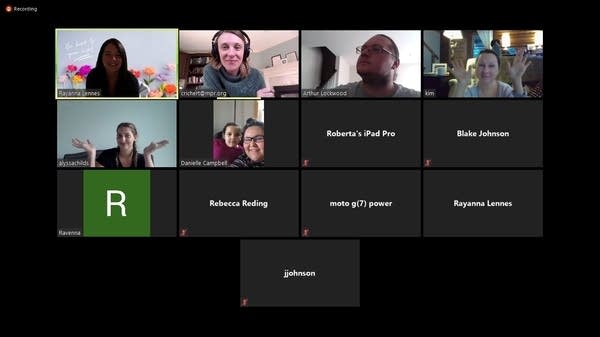In a pandemic, technology helps tribe reconnect with Dakota language

Go Deeper.
Create an account or log in to save stories.
Like this?
Thanks for liking this story! We have added it to a list of your favorite stories.
These days, Dakota — the native language of the Prairie Island Indian Community — isn't widely spoken.
But the tribe is trying to change that and the pandemic has offered them an unusual opportunity to do so: by bringing language classes online, they’ve been able to reach more members than ever before.
In person classes have typically attracted a handful of people, said tribe communications manager Rayanna Lennes.
Using technology like Zoom to teach live classes, and archiving them online, gives far-flung tribal members an opportunity to reconnect with their language — and each other.
Turn Up Your Support
MPR News helps you turn down the noise and build shared understanding. Turn up your support for this public resource and keep trusted journalism accessible to all.
"It's an hour a day, three days a week that we're all on, and we get to interact with each other, and it's this sense of community,” said Lennes, who participated in a class earlier this month over Zoom.
That includes Kim Campbell who lives in Washington State. She said the classes are a highlight during her otherwise dull weeks stuck at home.
And they're a reminder that her tribe, who are descendants of the Mdewakanton Band of Eastern Dakota, some of whom still live on the reservation near Red Wing, is thriving.
"It just makes you feel connected to your community. It means that we're still here,” Campbell said during a Zoom class earlier this month.
That session focused on giving commands — useful stuff when you're stuck at home with some unruly children.
Teacher Arthur Lockwood went over some basics like “go over there.”
“Heciya iyaya,” Lockwood pronounces slowly for the class before they give it a try.
But the class isn't just about memorizing and repeating new words. Lockwood focuses on intonation, context and nuance — like when it's OK to use a more casual version of a phrase.
"That kind of stuff all comes with the comfort of the language, you know?” Lockwood told the class.
For most students in this class, Dakota isn't comfortable, because learning it was not something many of them did as children. The language chain was broken many decades earlier when Dakota children were sent to boarding school. There, they were punished for speaking Dakota.
Over time, fluent speakers became sparse. Those who knew the language were scared to teach their children how to speak it for fear they would be ostracized, too.
Lockwood only heard his older relatives speak Dakota here and there as he grew up. At 17, he started learning the language in earnest.
"I asked my grandma to get me a dictionary. I started to study,” Lockwood said. “A word a day, I'd take out of that dictionary."
Since so few people speak Dakota, practice opportunities remain scarce. That's the real challenge in keeping the language alive among Prairie Island members, said Johnny Johnson, a tribal council member.
"When I was growing up, I heard it all the time when we were going to everybody's house,” he said. “Now, it's like the kids are learning but the parents aren't learning. It's very hard for them to speak or talk to them without someone else learning along with them."
Johnson said taking the lessons online and making them more widely available protects against the language fading from memory.
For his part, Lockwood said he only has one goal for the class.
“I hope that I work myself out of a job,” he said.



